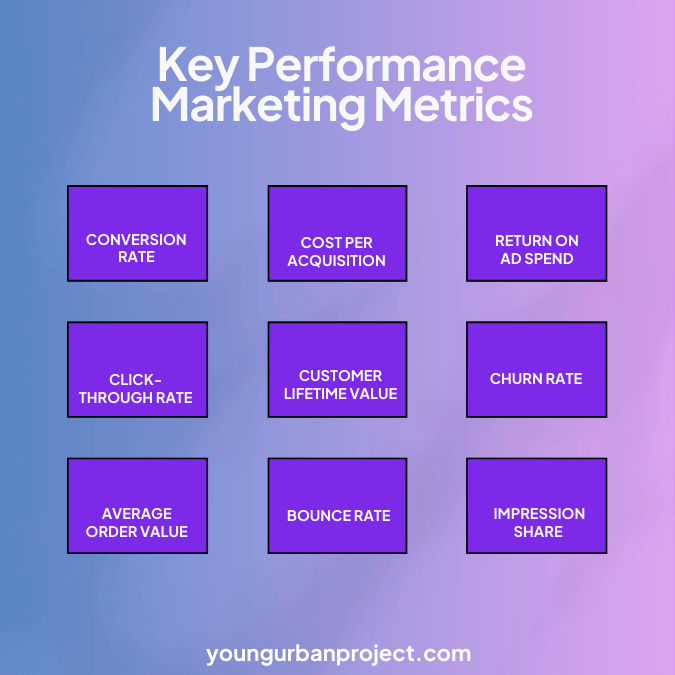Learn the key performance measures that marketers need to monitor to maximize return on investment and optimize their campaigns. This comprehensive guide covers crucial metrics like conversion rate, cost per acquisition (CPA), return on ad spend (ROAS), click-through rate (CTR), customer lifetime value (CLTV), churn rate, average order value (AOV), bounce rate, and impression share. Learn how to effectively monitor these metrics, understand their significance, and apply real-world examples to enhance your marketing strategies. Elevate your performance marketing knowledge with insights from industry experts and practical tips to achieve measurable results.
Table of Contents
Introduction to Performance Marketing Metrics
Performance marketing metrics are critical indicators that help marketers assess the effectiveness of their campaigns. These metrics provide insights into various aspects of marketing efforts, from user engagement to revenue generation. By closely monitoring these metrics, marketers can make informed decisions to optimize their strategies and maximize ROI.
How do performance marketing metrics work?
Performance marketing metrics work by providing quantifiable data that helps marketers evaluate the effectiveness of their campaigns. These metrics track various aspects of user behavior, engagement, and financial outcomes, allowing marketers to measure how well their strategies are performing. By analyzing these metrics, marketers can identify what’s working, what needs improvement, and where to allocate resources for the best return on investment. This data-driven approach enables continuous optimization, ensuring that marketing efforts are efficient and impactful.
What is the primary benefit of tracking performance marketing metrics?
The primary benefit of tracking performance marketing metrics is that it enables marketers to make data-driven decisions. By closely monitoring these metrics, marketers can assess the effectiveness of their campaigns, identify areas for improvement, and optimize their strategies to maximize return on investment. This approach leads to more efficient use of marketing resources, better targeting, and ultimately, improved business outcomes.
Key Performance Marketing Metrics

Conversion Rate
Definition: Conversion rate is the percentage of users who complete a desired action, such as purchasing, signing up for a newsletter, or filling out a form.
Importance: A high conversion rate indicates that your marketing efforts are effectively driving users to take the desired action. It’s a direct measure of campaign success.
How to Track: Use tools like Google Analytics to track conversion rates. Set up conversion goals and monitor the percentage of users who complete these goals.
Example: An e-commerce website tracks the conversion rate of visitors who add items to their cart and complete the checkout process. A higher conversion rate signifies an effective sales funnel.
Cost Per Acquisition (CPA)
Definition: CPA is the cost associated with acquiring a new customer through a marketing campaign.
Importance: Monitoring CPA helps marketers understand the efficiency of their spending. A lower CPA means higher efficiency in acquiring customers.
How to Track: Calculate CPA by dividing the total marketing spend by the number of new customers acquired. Use platforms like Google Ads to monitor CPA for specific campaigns.
Example: A company running Facebook Ads calculates the CPA by dividing the total ad spend by the number of customers gained from the ads. Lowering CPA indicates improved campaign performance.
Return on Ad Spend (ROAS)
Definition: ROAS measures the revenue generated for every dollar spent on advertising.
Importance: High ROAS indicates that your advertising efforts are generating substantial revenue compared to the money spent.
How to Track: Calculate ROAS by dividing the total revenue generated from ads by the total ad spend. Use advertising platforms to track this metric.
Example: An online retailer spends $1,000 on Google Ads and generates $5,000 in sales from those ads. The ROAS is 5:1, indicating a successful campaign.
Click-Through Rate (CTR)
Definition: CTR is the percentage of users who click on an ad or a link out of the total number of users who view it.
Importance: A high CTR indicates that your ad copy and visuals are compelling and relevant to your audience.
How to Track: Use advertising platforms like Google Ads or social media ad managers to monitor CTR.
Example: A company running a display ad campaign on a website sees a CTR of 2%. This means that 2% of the users who viewed the ad clicked on it, reflecting the ad’s effectiveness.
Customer Lifetime Value (CLTV)
Definition: CLTV is the total revenue a business can expect from a customer throughout their relationship.
Importance: Understanding CLTV helps businesses invest in retaining high-value customers and optimize long-term profitability.
How to Track: Calculate CLTV by multiplying the average purchase value, purchase frequency, and the average customer lifespan.
Example: A subscription service calculates the CLTV of a customer who spends $20 per month and stays subscribed for 24 months. The CLTV is $480, guiding the company’s retention strategies.
Churn Rate
Definition: Churn rate is the percentage of customers who stop using your product or service within a given period.
Importance: A high churn rate indicates issues with customer satisfaction or product value, necessitating improvements.
How to Track: Divide the number of customers lost during a period by the total number of customers at the beginning of the period.
Example: A SaaS company tracks the churn rate and finds that 5% of its customers cancel their subscriptions each month. Addressing the reasons for churn can help reduce this rate.
Average Order Value (AOV)
Definition: AOV is the average amount spent by customers per order.
Importance: Increasing AOV can boost overall revenue without acquiring new customers.
How to Track: Calculate AOV by dividing the total revenue by the number of orders.
Example: An online store tracks AOV and finds that customers spend an average of $50 per order. Implementing strategies like upselling and cross-selling can increase AOV.
Bounce Rate
Definition: Bounce rate is the percentage of visitors who leave a website after viewing only one page.
Importance: A high bounce rate indicates that the landing page is not engaging or relevant to visitors.
How to Track: Use tools like Google Analytics to monitor bounce rates for different pages on your website.
Example: A blog monitors the bounce rate of its articles. A high bounce rate on a particular article suggests the need for more engaging content or better alignment with user intent.
Impression Share
Definition: Impression share is the percentage of times your ads were shown out of the total opportunities they could have been shown.
Importance: A high impression share indicates strong ad visibility and effective targeting.
How to Track: Use advertising platforms to track impression share for your campaigns.
Example: A business running a PPC campaign on Google Ads tracks impression share to ensure their ads are reaching their target audience. Increasing impression share can lead to higher visibility and more clicks.
Conclusion
Tracking performance marketing metrics is essential for any marketer aiming to optimize their campaigns and achieve better ROI.
By focusing on key metrics like conversion rate, CPA, ROAS, CTR, CLTV, churn rate, AOV, bounce rate, and impression share, marketers can gain valuable insights and make data-driven decisions. Implementing these strategies and continuously monitoring these metrics will help businesses stay competitive and drive sustainable growth.
Performance marketing is all about precision and effectiveness. By keeping a close eye on these metrics, marketers can ensure their efforts are aligned with their goals and deliver the best possible results. Remember, the key to success in performance marketing lies in constant optimization and adaptation based on the insights gained from these metrics.
For those looking to master performance marketing, Young Urban Project offers the best performance marketing course available. With expert mentorship, practical assignments, and a comprehensive curriculum, you’ll gain the skills and knowledge needed to excel in the field.

